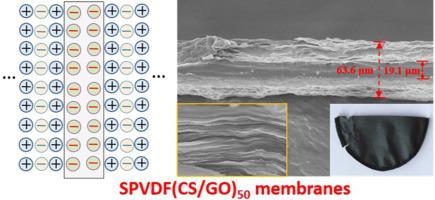当前位置:
X-MOL 学术
›
Eur. Polym. J.
›
论文详情
Our official English website, www.x-mol.net, welcomes your
feedback! (Note: you will need to create a separate account there.)
Constructing Anhydrous Proton Exchange Membranes through Alternate Depositing Graphene Oxide and Chitosan on Sulfonated Poly(vinylidenefluoride) or Sulfonated Poly(vinylidene fluoride-co-hexafluoropropylene) membranes
European Polymer Journal ( IF 5.8 ) Pub Date : 2021-01-01 , DOI: 10.1016/j.eurpolymj.2020.110160 Si Shen , Tingting Jia , Jing Jia , Ning Wang , Di Song , Jing Zhao , Jin Jin , Quantong Che
European Polymer Journal ( IF 5.8 ) Pub Date : 2021-01-01 , DOI: 10.1016/j.eurpolymj.2020.110160 Si Shen , Tingting Jia , Jing Jia , Ning Wang , Di Song , Jing Zhao , Jin Jin , Quantong Che

|
Abstract The proton exchange membranes (PEMs) have been constructed through alternate depositing chitosan (CS) and graphene oxide (GO) on the membrane substrates of sulfonated poly(vinylidenefluoride) (SPVDF) or sulfonated poly(vinylidene fluoride-co-hexafluoropropylene) (SPVDF-HFP). Phosphoric acid (PA) doped membranes were formed owing to the intermolecular hydrogen bonds, which were expected to work as PEMs in high temperature proton exchange membrane fuel cells (HTPEMFCs). The prepared layer-by-layer (LBL) depositional composite membranes showed the fine capacity to combine PA molecules with the lower dimension swelling. As expected, SPVDF(CS/GO)50/PA and SPVDF-HFP(CS/GO)50/PA membranes respectively exhibited higher proton conductivity values of 2.34×10-1 S/cm and 1.56×10-1 S/cm at 140 °C. Furthermore, the proton conductivity values of 3.52×10-1 S/cm and 2.25×10-1 S/cm at 140 °C in a 500-hour non-stop test could correspond to the negligible leakage of the depositional layers from the composite membranes. Because the doped PA molecules entered the gaps between the depositional layers, the prepared PA doped membranes possessed the enhanced mechanical strength owing to the compacted structure. Most interestingly, the prepared LBL deposited membranes could retain the better tensile stress even if PA molecules were doped with the formation of SPVDF(CS/GO)50/PA and SPVDF-HFP(CS/GO)50/PA membranes. Meanwhile, the proper thermal stability, methanol permeability and proton conductivity stability of the prepared membranes could suggest that the strategy of alternate depositing the functional components on membrane substrates is substantially more effective at improving the grade of PEMs. In our opinion, the fine balance on proton conductivity and mechanical property could make them stand out from other candidates as PEMs for HTPEMFCs.
中文翻译:

通过在磺化聚(偏二氟乙烯)或磺化聚(偏二氟乙烯-共六氟丙烯)膜上交替沉积氧化石墨烯和壳聚糖来构建无水质子交换膜
摘要 通过在磺化聚偏二氟乙烯 (SPVDF) 或磺化聚偏二氟乙烯-共六氟丙烯 (SPVDF) 膜基材上交替沉积壳聚糖 (CS) 和氧化石墨烯 (GO) 构建了质子交换膜 (PEM)。 -HFP)。由于分子间氢键,形成了磷酸 (PA) 掺杂的膜,有望在高温质子交换膜燃料电池 (HTPEMFC) 中用作 PEM。制备的逐层 (LBL) 沉积复合膜显示出结合 PA 分子的良好能力和较低尺寸的溶胀。正如预期的那样,SPVDF(CS/GO)50/PA 和 SPVDF-HFP(CS/GO)50/PA 膜分别表现出更高的质子电导率值,分别为 2.34×10-1 S/cm 和 1.56×10-1 S/cm 140℃。此外,质子电导率为 3。52×10-1 S/cm 和 2.25×10-1 S/cm 在 140 °C 下在 500 小时不间断测试中可能对应于可忽略的沉积层从复合膜的泄漏。由于掺杂的 PA 分子进入沉积层之间的间隙,制备的 PA 掺杂膜由于结构紧凑而具有增强的机械强度。最有趣的是,即使 PA 分子掺杂形成 SPVDF(CS/GO)50/PA 和 SPVDF-HFP(CS/GO)50/PA 膜,制备的 LBL 沉积膜也能保持更好的拉伸应力。同时,制备的膜具有适当的热稳定性、甲醇渗透性和质子传导性稳定性,表明在膜基材上交替沉积功能组分的策略在提高 PEM 的等级方面更为有效。
更新日期:2021-01-01
中文翻译:

通过在磺化聚(偏二氟乙烯)或磺化聚(偏二氟乙烯-共六氟丙烯)膜上交替沉积氧化石墨烯和壳聚糖来构建无水质子交换膜
摘要 通过在磺化聚偏二氟乙烯 (SPVDF) 或磺化聚偏二氟乙烯-共六氟丙烯 (SPVDF) 膜基材上交替沉积壳聚糖 (CS) 和氧化石墨烯 (GO) 构建了质子交换膜 (PEM)。 -HFP)。由于分子间氢键,形成了磷酸 (PA) 掺杂的膜,有望在高温质子交换膜燃料电池 (HTPEMFC) 中用作 PEM。制备的逐层 (LBL) 沉积复合膜显示出结合 PA 分子的良好能力和较低尺寸的溶胀。正如预期的那样,SPVDF(CS/GO)50/PA 和 SPVDF-HFP(CS/GO)50/PA 膜分别表现出更高的质子电导率值,分别为 2.34×10-1 S/cm 和 1.56×10-1 S/cm 140℃。此外,质子电导率为 3。52×10-1 S/cm 和 2.25×10-1 S/cm 在 140 °C 下在 500 小时不间断测试中可能对应于可忽略的沉积层从复合膜的泄漏。由于掺杂的 PA 分子进入沉积层之间的间隙,制备的 PA 掺杂膜由于结构紧凑而具有增强的机械强度。最有趣的是,即使 PA 分子掺杂形成 SPVDF(CS/GO)50/PA 和 SPVDF-HFP(CS/GO)50/PA 膜,制备的 LBL 沉积膜也能保持更好的拉伸应力。同时,制备的膜具有适当的热稳定性、甲醇渗透性和质子传导性稳定性,表明在膜基材上交替沉积功能组分的策略在提高 PEM 的等级方面更为有效。











































 京公网安备 11010802027423号
京公网安备 11010802027423号